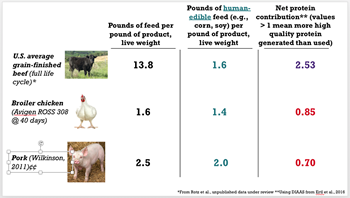Focus on Sustainability
 Beef industry should communicate beef's underlying value proposition — transforming lower-value resources into high-quality proteins.
Beef industry should communicate beef's underlying value proposition — transforming lower-value resources into high-quality proteins.
by Lindsay King, assistant editor
LOVELAND, Colo., June 21, 2018 — Cattle are the original plant-based protein, shared Sara Place, the senior director of sustainable beef production research for the National Cattlemen’s Beef Association (NCBA), a point to keep in mind as she handed out some heartburn discussing sustainability in beef production. Place spoke during the opening general session of the 2018 Beef Improvement Federation Research Symposium and Convention hosted June 20-23 in Loveland, Colo.

Sara Place made the point that beef production essentially makes plant-based protein (veggie burgers) sustainable.
By the end of her presentation, Place made the point that beef production essentially makes plant-based protein (veggie burgers) sustainable. These burgers are made out of peas, wheat, etc., and they produce byproducts that cattle eat to make the real, original burger.
“Plant-based meat is a really interesting concept to me. People want to buy a more sustainable product, and to them that is the veggie burger,” Place said. “They market themselves as made from plants, and this is supposed to make them better.”
This “plant-forward diet” is a trend sweeping the nation, implying that meat, specifically beef, is not good for the planet.
“It seems like every day we have a study come out saying that beef is terrible for the planet,” Place added. “One article in the Science Journal, a very reputable publication, said that eating less red meat would leave us better off. There are a lot of statistics being thrown out there, but we have to remember, there are lies, damn lies and statistics.”
One environmental complaint pertains to the carbon footprint left by cattle production. To address the topic of “less meat, less heat,” Place compared meat consumption today to that of 1909.
“Americans actually eat the same amount of beef today as they did in 1909, but they eat 500% more chicken,” Place said. “The total amounts are higher because the population is larger, but the comparison is the same.”
Red meat consumption is down 3% while total meat consumption is up 53%.
“We are now a chicken-eating nation. That should cause those of us in the beef industry a little bit of concern,” Place joked. “Per capita consumption of beef is declining, but demand is not. That needs to be very clear.”
In 1976, beef consumption peaked, she noted. Contrary to popular opinion, declining consumption of beef is not the driving force of reducing carbon emissions. Increased productivity and efficiency is the real culprit of the reduction.
“If we produced the same amount of beef today with the practices of 1976, we would need 129 million head to feed the same amount of mouths instead of the 94 million head we need with our current practices,” Place explained.
Place called producers to action: Tell the story of agriculture, the original producers of plant-based burgers.
“The fundamental value proposition of beef to the food system is the transformation of lower-value resources, plants and land bases to higher-value protein, micronutrients and ancillary products,” Place said. “What can we do to enhance this upcycling value while minimizing unwanted negative outcomes and increase social acceptability?”
 Monogastric and ruminant comparisons revealed that cattle are more efficient at using lower-quality protein than chickens and hogs, Place shared. While cattle consume more total pounds of feed than chickens or pigs to produce a pound of live weight, much of that is feedstuffs not edible by humans. When you compare how many pounds of human-edible feedstuffs it takes to produce a pound of live weight, beef beats pork, and when you consider the net protein contribution, beef beats both pork and chicken. Cattle produce significantly more high-quality protein than they use, while chickens and hogs use more than they produce.
Monogastric and ruminant comparisons revealed that cattle are more efficient at using lower-quality protein than chickens and hogs, Place shared. While cattle consume more total pounds of feed than chickens or pigs to produce a pound of live weight, much of that is feedstuffs not edible by humans. When you compare how many pounds of human-edible feedstuffs it takes to produce a pound of live weight, beef beats pork, and when you consider the net protein contribution, beef beats both pork and chicken. Cattle produce significantly more high-quality protein than they use, while chickens and hogs use more than they produce.
“People are eating more chicken, and we are giving up a lot of potential growth in our products because of this issue,” Place said. “We have made a lot of progress towards producing a sustainable product. We need to focus on increasing red meat yield and whole maintenance cost.”
Place urged producers to use beef’s main competitive advantage: rumination. She challenged them to think about ways to take more advantage of the ruminant animal's ability to convert otherwise inedible feedstuffs into human-edible protein, which ultimately frames their competitive edge over other sources of protein.
Editor’s Note: The articles used within this site represent a mixture of copyrights. If you would like to reprint or repost an article, you must first request permission of Angus Media by contacting the editor at 816-383-5200; 3201 Frederick Ave., Saint Joseph, MO 64506. Angus Media claims copyright to this web site as presented. We welcome educational venues and cattlemen to link to this site as a service to their audience.


